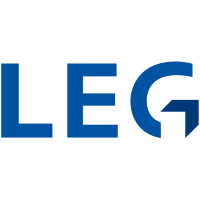
LEG Immobilien SE
XETRA:LEG


| US |

|
Johnson & Johnson
NYSE:JNJ
|
Pharmaceuticals
|
| US |

|
Berkshire Hathaway Inc
NYSE:BRK.A
|
Financial Services
|
| US |

|
Bank of America Corp
NYSE:BAC
|
Banking
|
| US |

|
Mastercard Inc
NYSE:MA
|
Technology
|
| US |

|
UnitedHealth Group Inc
NYSE:UNH
|
Health Care
|
| US |

|
Exxon Mobil Corp
NYSE:XOM
|
Energy
|
| US |

|
Pfizer Inc
NYSE:PFE
|
Pharmaceuticals
|
| US |

|
Palantir Technologies Inc
NYSE:PLTR
|
Technology
|
| US |

|
Nike Inc
NYSE:NKE
|
Textiles, Apparel & Luxury Goods
|
| US |

|
Visa Inc
NYSE:V
|
Technology
|
| CN |

|
Alibaba Group Holding Ltd
NYSE:BABA
|
Retail
|
| US |

|
3M Co
NYSE:MMM
|
Industrial Conglomerates
|
| US |

|
JPMorgan Chase & Co
NYSE:JPM
|
Banking
|
| US |

|
Coca-Cola Co
NYSE:KO
|
Beverages
|
| US |

|
Walmart Inc
NYSE:WMT
|
Retail
|
| US |

|
Verizon Communications Inc
NYSE:VZ
|
Telecommunication
|
Utilize notes to systematically review your investment decisions. By reflecting on past outcomes, you can discern effective strategies and identify those that underperformed. This continuous feedback loop enables you to adapt and refine your approach, optimizing for future success.
Each note serves as a learning point, offering insights into your decision-making processes. Over time, you'll accumulate a personalized database of knowledge, enhancing your ability to make informed decisions quickly and effectively.
With a comprehensive record of your investment history at your fingertips, you can compare current opportunities against past experiences. This not only bolsters your confidence but also ensures that each decision is grounded in a well-documented rationale.
Do you really want to delete this note?
This action cannot be undone.

| 52 Week Range |
67.94
96.1
|
| Price Target |
|
We'll email you a reminder when the closing price reaches EUR.
Choose the stock you wish to monitor with a price alert.

|
Johnson & Johnson
NYSE:JNJ
|
US |

|
Berkshire Hathaway Inc
NYSE:BRK.A
|
US |

|
Bank of America Corp
NYSE:BAC
|
US |

|
Mastercard Inc
NYSE:MA
|
US |

|
UnitedHealth Group Inc
NYSE:UNH
|
US |

|
Exxon Mobil Corp
NYSE:XOM
|
US |

|
Pfizer Inc
NYSE:PFE
|
US |

|
Palantir Technologies Inc
NYSE:PLTR
|
US |

|
Nike Inc
NYSE:NKE
|
US |

|
Visa Inc
NYSE:V
|
US |

|
Alibaba Group Holding Ltd
NYSE:BABA
|
CN |

|
3M Co
NYSE:MMM
|
US |

|
JPMorgan Chase & Co
NYSE:JPM
|
US |

|
Coca-Cola Co
NYSE:KO
|
US |

|
Walmart Inc
NYSE:WMT
|
US |

|
Verizon Communications Inc
NYSE:VZ
|
US |
This alert will be permanently deleted.
 LEG Immobilien SE
LEG Immobilien SE
LEG Immobilien SE
LEG Immobilien SE is a key player in the German residential real estate market, skillfully navigating a sector characterized by both stability and strategic growth. Founded in 1970 and headquartered in Düsseldorf, the company has evolved into one of Germany's largest property groups, managing an impressive portfolio predominantly situated in the country's northwestern regions. LEG's business revolves around the ownership and management of residential properties. The company strategically manages its portfolio to align with demographic and economic trends, which helps ensure high occupancy rates and consistent rental income. This steady stream of rental income forms the backbone of LEG's revenue, enabling it to maintain a strong financial base while also permitting generous reinvestment into property improvements and expansions.
The company’s operations extend beyond mere property management. LEG employs a thorough approach to asset quality enhancement, focusing on modernization projects to boost property value and tenant satisfaction. This focus not only enhances living conditions for its residents but also augments the company’s ability to charge competitive rents. Furthermore, LEG has been increasingly incorporating sustainability initiatives within its operational model, recognizing the growing importance of eco-friendly practices in real estate. By conscientiously implementing energy-efficient upgrades and adhering to sustainable building standards, LEG not only meets regulatory requirements but also positions itself favorably towards environmentally-conscious tenants, subsequently stabilizing its occupancy levels and long-term profitability.

LEG Immobilien SE is a key player in the German residential real estate market, skillfully navigating a sector characterized by both stability and strategic growth. Founded in 1970 and headquartered in Düsseldorf, the company has evolved into one of Germany's largest property groups, managing an impressive portfolio predominantly situated in the country's northwestern regions. LEG's business revolves around the ownership and management of residential properties. The company strategically manages its portfolio to align with demographic and economic trends, which helps ensure high occupancy rates and consistent rental income. This steady stream of rental income forms the backbone of LEG's revenue, enabling it to maintain a strong financial base while also permitting generous reinvestment into property improvements and expansions.
The company’s operations extend beyond mere property management. LEG employs a thorough approach to asset quality enhancement, focusing on modernization projects to boost property value and tenant satisfaction. This focus not only enhances living conditions for its residents but also augments the company’s ability to charge competitive rents. Furthermore, LEG has been increasingly incorporating sustainability initiatives within its operational model, recognizing the growing importance of eco-friendly practices in real estate. By conscientiously implementing energy-efficient upgrades and adhering to sustainable building standards, LEG not only meets regulatory requirements but also positions itself favorably towards environmentally-conscious tenants, subsequently stabilizing its occupancy levels and long-term profitability.





























 You don't have any saved screeners yet
You don't have any saved screeners yet
